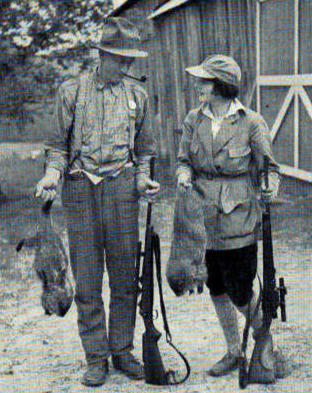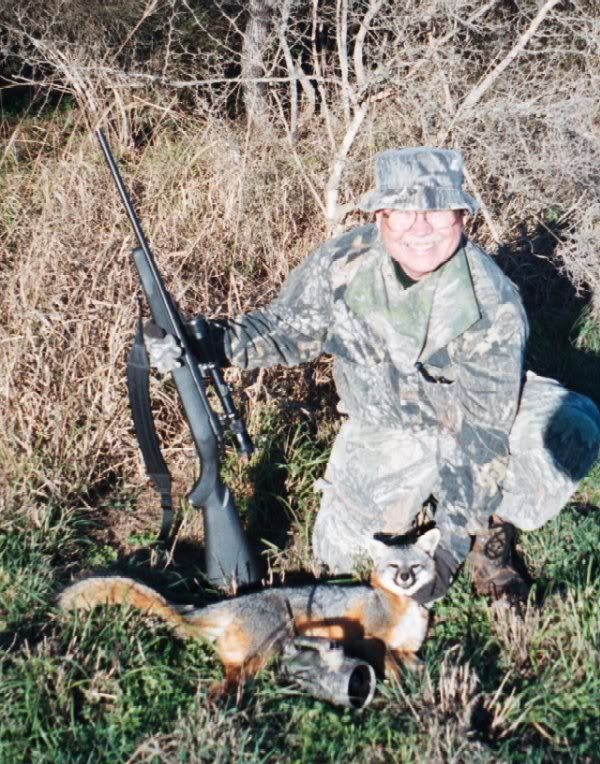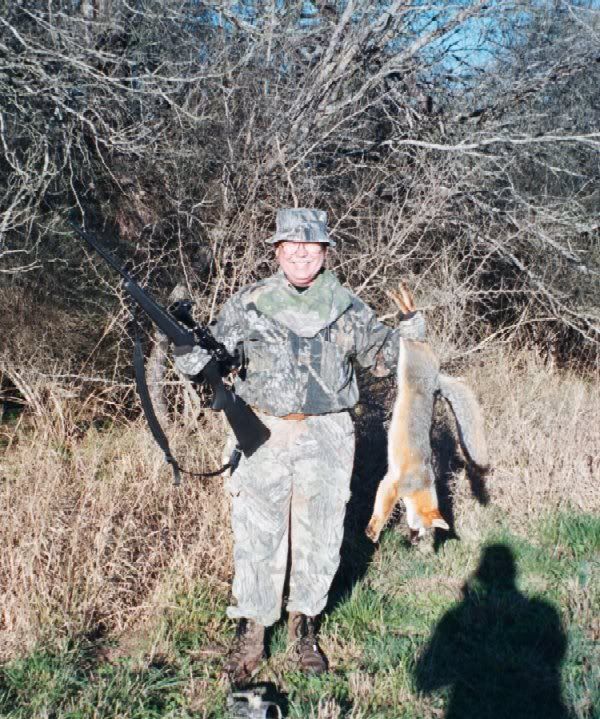

 The Accurate Reloading Forums
The Accurate Reloading Forums  THE ACCURATE RELOADING.COM FORUMS
THE ACCURATE RELOADING.COM FORUMS  Hunting
Hunting  Varmint Hunting
Varmint Hunting  South Texas Gray Fox
South Texas Gray FoxGo  | New  | Find  | Notify  | Tools  | Reply  |  |
| one of us |
I did get to do some calling last Sunday down near Pearsall, TX. I called in and shot a nice gray fox after the rancher told us he was pretty sure there weren't any foxes on the ranch. I was using the FOXPRO & the famous Rabbit #2 sound. This was my first fox using the new Barnes 53 gr. Triple Shock bullets in my 22-250. There was a bullet sized entry and a 2" exit. I am very pleased with them. I thought I might get more damage on a fox. It is time to load some more up....... Good Hunting, Bob   There is room for all of God's creatures....right next to the mashed potatoes. http://texaspredatorposse.ipbhost.com/  | ||
|
| one of us |
I'm sure someone knows their foxes much better than I do, but despite the gray tinge on the back, I think that you have a red fox there. My impression is that "grays" are an Eastern U.S. species and that "reds" are spread across the mid-continent. (I won't be offended if someone corrects me.) | |||
|
| one of us |
We have both Red and Gray Fox here is Texas. The Red is larger than the Gray, has longer legs which are black at the bottom, a white tipped tail, and a red body.  Here is a better photo of a gray for you:  From Texas Parks & Wildlife "Gray Fox Distribution in Texas: Statewide." Habits. The gray fox is essentially an inhabitant of wooded areas, particularly mixed hardwood forests. It is common throughout the wooded sections east of the shortgrass plains and in the pinyon-juniper community above the low lying deserts. This fox is adept at climbing trees, particularly if they are leaning or have branches within 3 m of the ground, and it is not unusual for it to use this escape device when pursued by hounds. Contrary to common belief, gray foxes are not strictly animals of the night, but they are much more active then. They have been observed on many occasions in the daytime under conditions that suggested they were foraging. When so encountered, they often move to one side behind a protecting screen of vegetation and wait for the intruder to pass. Gray foxes usually den in crevices in the rocks, in underground burrows, under rocks, in hollow logs, or in hollow trees. In eastern Texas, one was found denning about 10 m above the ground in a large hollow oak. In central Texas, a den was found in a hollow live oak with the entrance about 1 m above the ground. Two unusual den sites which have been documented include a pile of wood and a field of sorghum into which a fox had "tunneled." The gray fox is omnivorous; the food varies with season and availability. Based upon the stomach contents of 42 foxes from Texas, the winter food consisted chiefly of small mammals (cottontails, cotton rats, pocket gophers, pocket mice), 56%; followed by insects, largely grasshoppers, 23%; and birds (doves, quail, sparrows, blackbirds, towhees), 21%. In the spring the diet was but slightly changed — small mammals, 68%; insects, 25%; small birds, 17%. In late summer and fall, persimmons and acorns led with 30%; insects, 26%; small mammals, 16%; birds, 14%; crayfish, 14%. In these 42 stomachs, chicken and quail occurred once each, and mourning doves twice. Consequently, as judged from these analyses, the usual food habits of the gray fox do not conflict much with man’s economy. In Texas, the breeding season begins in December and continues on into March. Most females captured in March and April are gravid. The three to six pups are born in April or May after a gestation period of about 53 days. At first they are blind and helpless, but they grow rapidly and soon leave the home nest, possibly because of the heavy infestation of fleas characteristic of such nests. Then they seek shelter in rock piles, under rocks, in piles of brush, or in other sites that offer concealment and protection. Of some interest is the possible relationship between gray foxes and coyotes. In sections of Texas where coyotes formerly were numerous, the gray fox was scarce; now, after elimination of the coyote, the gray fox has become abundant. Perhaps the coyote tends to hold this fox in check under conditions where they both occupy the same area. Gray foxes are thought to live six to 10 years in the wild. Major factors causing mortality include predation, parasites, diseases, and man. The gray fox is among the most important of Texas’ fur-bearing animals." There is room for all of God's creatures....right next to the mashed potatoes. http://texaspredatorposse.ipbhost.com/  | |||
|
One of Us |
Nah, that's a gray fox (Urocyon cinereoargenteus) the colors vary a bit from region to region and from individual to individual. But that is most definitely a gray fox.
Nope, they're very widespread as shown on this range map,  Check out this site, Gray Fox on the IUCN Canid Site And then check out the Canid Species Accounts and take a look at some of the South American variants, pretty cool species. Gray fox as a species are the oldest of the canids, meaning they've existed for at least 4 million years in their present form. Gray wolves by comparison have been around for about 1 million years. This according to the fossil evidence. | |||
|
| one of us |
hey bob congrats on the fox! which old grey is you? ignorance is just another varmint that needs killin'! | |||
|
| one of us |
I'm the one on the left.....and I earned every gray hair............ There is room for all of God's creatures....right next to the mashed potatoes. http://texaspredatorposse.ipbhost.com/  | |||
|
| one of us |
Bob, thanks for the taxonomy lesson. I gladly stand corrected. Now, which of the two is more common in Texas? (not a trick question, my curiosity is just aroused) When hunting in northern Alberta, we came across some very un-shy little foxes that the locals called a calico fox. They were colored just like a calico cat -- all mottled with yellow, gray, black, and reddish markings. I've got a video of one totting right up the road and around the truck we're sitting in in broad daylight. | |||
|
| one of us |
here in north texas grays are most common!but I rarely even see them! ignorance is just another varmint that needs killin'! | |||
|
| one of us |
Bob Nice Fox. They make a great life size mount. DOUBLE RIFLE SHOOTERS SOCIETY | |||
|
| one of us |
Bob-NICE GOING on bagging the grey fox. That's not an easy task with a rifle as there is a lot of air around those tiny creatures. I don't call very much anymore but I do trap them and have a few waiting to be shipped for sale in the next few days. But the price is not very good (app. $10 for a #1 pelt). The grey fox is one of the prettiest wild animals we have here in TX. I keep telling myself I am going to keep one and send it to the taxidermist, but I never seem to get around to doing so. Also, thanks for the report on the bullets. I've been hoping to try them but haven't got around to it just yet. Bobby Μολὼν λαβέ The most important thing in life is not what we do but how and why we do it. - Nana Mouskouri | |||
|
| one of us |
SC, The gray is much more common in Texas...... Bob There is room for all of God's creatures....right next to the mashed potatoes. http://texaspredatorposse.ipbhost.com/  | |||
|
| one of us |
Bobby, I really like the TSX bullets. I am using them in my 7mm-08 also. So far they have performed very well on whitetails, hogs, and coyotes with the 140 gr. TSX. I have also taken hogs and coyotes with the 53. gr. TSX in the 22-250. The fox is going to Lisa at Wildthings Taxidermy in Boerne for a pedestal mount..... Bob There is room for all of God's creatures....right next to the mashed potatoes. http://texaspredatorposse.ipbhost.com/  | |||
|
| one of us |
nice fox bob, by the way did you get my message i sent you through the texas pred posse board about black buck hunting? | |||
|
| one of us |
Hey Cold, I didn't. Try a PM or just e-mail me directly. I wish you were coming on the Posse Hog Hunt this weekend!! Bob There is room for all of God's creatures....right next to the mashed potatoes. http://texaspredatorposse.ipbhost.com/  | |||
|
| new member |
Bob in TXHave you shot any coyotes with the 53 grainers, how were they on the furs? From what I've read these bullets are supposed to be very fur friendlyout of the 22-250. Don't know if the cost is worth it though. Also what kind of loads have you had good success with? | |||
|
| One of Us |
I am going on a hog hunt down there on the 10th of Feb. Hope I can bring my 222 and try to call one in. I have never been fortunate enough to get a fox. I have a full body bobcat and coyote, need the fox now! Keep yer powder dry and yer knife sharp. | |||
|
| One of Us |
I believe there are a lot more fox in TX than folks would think... I have seen a few in the hill country while deer hunting, and several friends talk about the numbers they see out west. But on another subject, I will never kill another one. I trapped what I believe was a mated pair about 25 years ago, when hides still brought a few dollars. I got $25 apiece for them, and even back then thought that wasn't enough to justify killing such a beautiful and secretive little animal. | |||
|
| Powered by Social Strata |
| Please Wait. Your request is being processed... |
|

Visit our on-line store for AR Memorabilia

